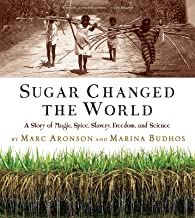
Written for children in grades 7-9, Sugar Changed the World, by Marc Aronson and Marina Budhos, is an examination of slavery using sugar as the focal point. True, Part I details the the history of sugar from its origin in New Guinea c. 9000-8000 B.C. to Christopher Columbus who brought sugar cane to the New World. After that, in Parts 2, 3, and 4, the book is about various aspects of slavery including the brutal exploitation of people especially on sugar plantations, the rise of the abolitionist movement, and changes and practices in the sugar industry such as the use of indentured Asians and the reform efforts of Mohandas Gandhi.
One of the highlights of the book is it source material. Songs, oral histories, and archival illustrations with explanatory captions are woven throughout the text and teach their own lessons. They give depth and perspective to the events being described and add enormously to the educational value of the book. Maps show the migration of people due to the sugar cane trade and help explain the distribution of people in the Americas.
The title of the book is appropriate but may be a little misleading because of the huge focus of the book on slavery. The historical background concerning the role of sugar in history, however, is interesting even if perhaps narrow. I enjoyed reading the book but think the topic might be a hard sell for kids in middle school, the target audience.
To buy Sugar Changed the World from Amazon, click here.